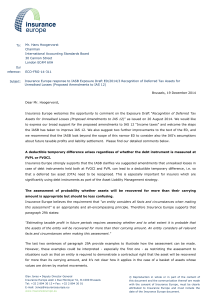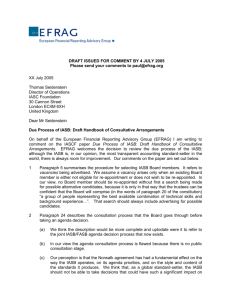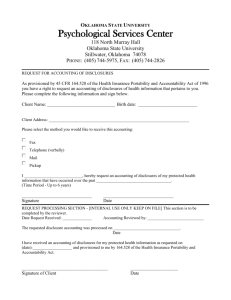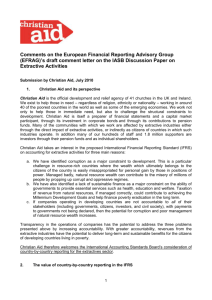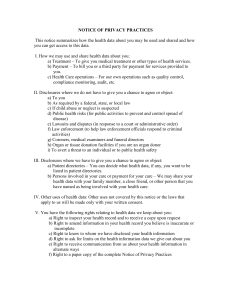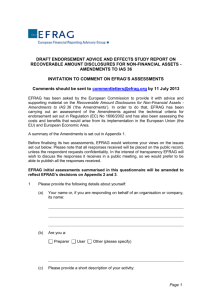International Accounting Standards Board 30 Cannon Street London
advertisement
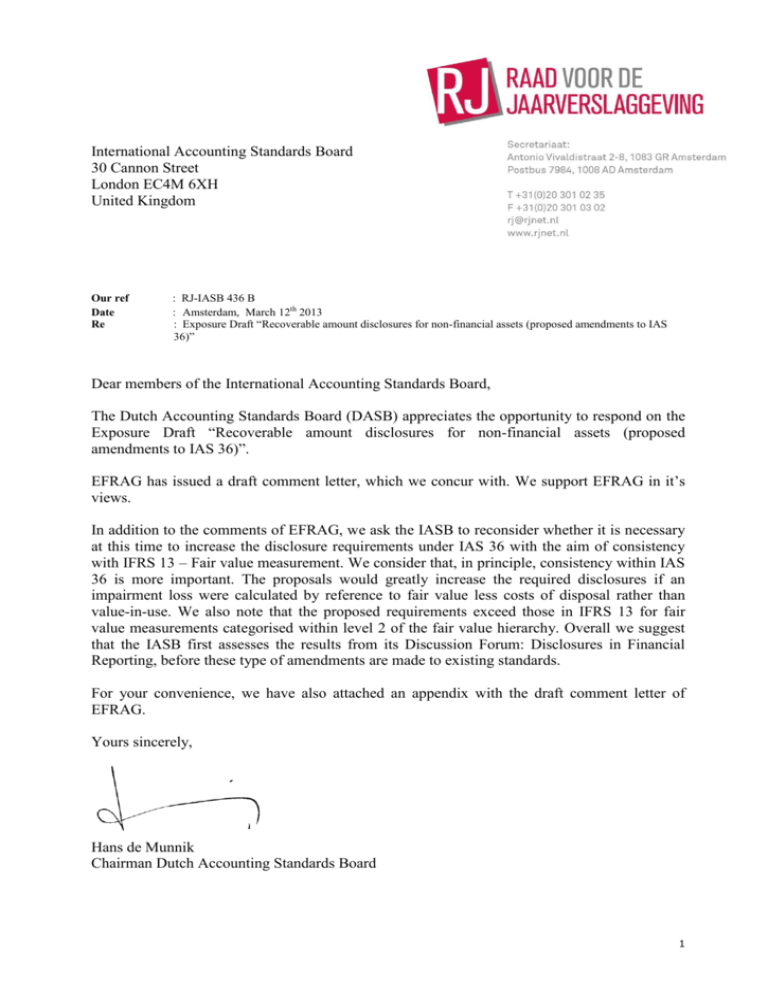
International Accounting Standards Board 30 Cannon Street London EC4M 6XH United Kingdom Our ref Date Re : RJ-IASB 436 B : Amsterdam, March 12th 2013 : Exposure Draft “Recoverable amount disclosures for non-financial assets (proposed amendments to IAS 36)” Dear members of the International Accounting Standards Board, The Dutch Accounting Standards Board (DASB) appreciates the opportunity to respond on the Exposure Draft “Recoverable amount disclosures for non-financial assets (proposed amendments to IAS 36)”. EFRAG has issued a draft comment letter, which we concur with. We support EFRAG in it’s views. In addition to the comments of EFRAG, we ask the IASB to reconsider whether it is necessary at this time to increase the disclosure requirements under IAS 36 with the aim of consistency with IFRS 13 – Fair value measurement. We consider that, in principle, consistency within IAS 36 is more important. The proposals would greatly increase the required disclosures if an impairment loss were calculated by reference to fair value less costs of disposal rather than value-in-use. We also note that the proposed requirements exceed those in IFRS 13 for fair value measurements categorised within level 2 of the fair value hierarchy. Overall we suggest that the IASB first assesses the results from its Discussion Forum: Disclosures in Financial Reporting, before these type of amendments are made to existing standards. For your convenience, we have also attached an appendix with the draft comment letter of EFRAG. Yours sincerely, Hans de Munnik Chairman Dutch Accounting Standards Board 1 Draft Comment Letter Comments should be submitted by 11 March 2013 to Commentletters@efrag.org xx March 2013 International Accounting Standards Board 30 Cannon Street London EC4M 6XH United Kingdom Dear Sir/Madam, Re: Exposure Draft Recoverable Amount Disclosures for Non-Financial Assets (Proposed Amendments to IAS 36) On behalf of the European Financial Reporting Advisory Group (EFRAG), I am writing to comment on the Exposure Draft ED/2013/1, Recoverable Amount Disclosures for NonFinancial Assets (Proposed Amendments to IAS 36) (the ‘ED’), issued by the IASB on 18 January 2013. This letter is intended to contribute to the IASB’s due process and does not necessarily indicate the conclusions that would be reached by EFRAG in its capacity as advisor to the European Commission on endorsement of the definitive IFRS in the European Union and European Economic Area. To summarise, EFRAG agrees with the proposal as it removes burdensome disclosures without reducing the relevance and understandability of the financial information. Our detailed comments and responses to the questions in the ED are set out in the appendix. If you would like to discuss our comments further, please do not hesitate to contact Giorgio Acunzo or me. Yours sincerely, Françoise Flores EFRAG Chairman Page 1 of 4 IASB ED: Recoverable Amount Disclosures for Non-Financial Assets APPENDIX Question 1 – Disclosures of recoverable amount The IASB proposes to remove the requirement in paragraph 134(c) to disclose the recoverable amount of each cash-generating unit (group of units) for which the carrying amount of goodwill or intangible assets with indefinite useful lives allocated to that unit (group of units) is significant when compared to the entity’s total carrying amount of goodwill or intangible assets with indefinite useful lives. In addition, the IASB proposes to amend paragraph 130 to require an entity to disclose the recoverable amount of an individual asset (including goodwill) or a cash-generating unit for which the entity has recognised or reversed an impairment loss during the reporting period. Do you agree with the proposed amendments? If not, why and what alternative do you propose? Question 2 – Disclosures of the measurement of fair value less costs of disposal The IASB also proposes to include in paragraph 130 the requirement to disclose the following information about the fair value less costs of disposal of an individual asset (including goodwill) or a cash-generating unit for which the entity has recognised or reversed an impairment loss during the reporting period: (a) the valuation technique(s) used to measure fair value less costs of disposal and, if there has been a change in the valuation technique, that change and the reason(s) for making it; (b) the level of the fair value hierarchy within which the fair value measurement of the asset is categorised in its entirety (without taking into account whether the ‘costs of disposal’ are observable); and (c) for fair value measurements that are categorised within Levels 2 and 3 of the fair value hierarchy, the key assumptions used in the measurement. Do you agree with the proposed amendments? If not, why and what alternative do you propose? Question 3 –Transition provisions The IASB proposes that the amendments should be applied retrospectively for annual periods beginning on or after 1 January 2014. The IASB also proposes to permit earlier application, but will not require an entity to apply those amendments in periods (including comparative periods) in which the entity does not also apply IFRS 13. Do you agree with the proposed transition method and effective date? If not, why and what alternative do you propose? Question 4 – Other comments Do you have any other comments on the proposals? Page 2 of 4 IASB ED: Recoverable Amount Disclosures for Non-Financial Assets Notes to constituents 1 The IASB amended the disclosures requirements in paragraph 134 of IAS 36 Impairment of Assets regarding the measurement of the recoverable amount of impaired assets in May 2012 when it published IFRS 13 Fair Value Measurement. IFRS 13 is effective from 1 January 2013. 2 These amendments to IAS 36 were aimed to align IAS 36 with the disclosures requirements in US GAAP about impaired assets and to require additional disclosures when the recoverable amount of assets was based on Fair Value Less Cost of Disposal (the ‘FVLCD’). 3 In December 2012, the IASB acknowledged that the amendments actually resulted in requiring the additional disclosures of the recoverable amount of any cashgenerating unit (or group of units) for which the carrying amount of goodwill or intangible assets with indefinite useful life allocated to that unit (or group of units) is significant in comparison with the entity’s total carrying amount of goodwill or intangible assets with indefinite useful life. 4 Furthermore, the IASB noted that these disclosures should have been placed in paragraph 130 which deals with disclosures requirements for each material impairment loss recognised or reversed during the period for an individual asset or cash-generating unit whose recoverable amount is FVLCD. 5 Therefore, the IASB proposes to correct this oversight by removing from paragraph 134 of IAS 36 references to the recoverable amount of assets and adding them to paragraph 130 together with the additional disclosures requirements added by IFRS 13. 6 Furthermore, the IASB also noted that the Exposure Draft ED/2012/1 Annual Improvements to IFRSs 2010-2012 Cycle included a proposed amendment to paragraph 130 of IAS 36 aimed at clarifying that an entity should disclose the discount rate used in measuring FVLCD by using a present value technique. Therefore, the IASB decided to combine the proposal from the ED/2012/1 with the amendments discussed above and to address all changes to the recoverable amount disclosures in a separate ED. The IASB is also proposing to remove the term ‘material’ from paragraph 130 as it believes that all IFRSs are already governed by the concept of materiality. 7 Finally, the IASB proposes that the amendment should be applied retrospectively for annual periods beginning on or after 1 January 2014. Early application is permitted provided that the entity also applies IFRS 13. EFRAG’s response EFRAG agrees with these proposed amendments. Enhanced Disclosures 8 EFRAG supports the proposed amendments to IAS 36 as they provide a timely correction of this oversight and they could have resulted in burdensome disclosures for preparers not outweighed by any benefits to users of financial statements. Therefore, we agree with the proposed amendments. Page 3 of 4 IASB ED: Recoverable Amount Disclosures for Non-Financial Assets 9 In EFRAG’s view, these amendments will alleviate some of the operational burden for preparers as they will be required to provide disclosures on the recoverable amount and on the key assumptions used to asses it only when impairment loss are either recognised or reversed. We believe that this improves the relevance of financial information. 10 Furthermore, entities will not be required to provide qualitative and quantitative information on recoverable amount for each cash-generating unit (or group of units) for which the carrying amount of goodwill or intangible assets with indefinite useful life allocated to that unit (or group of units) is significant in comparison with the entity’s total carrying amount of goodwill or intangible assets with indefinite useful life. EFRAG believes that this avoids boiler-plate disclosures not relevant to users about cash-generating units that are not impaired and therefore enhances both the relevance and the understandability of disclosures on recoverable amount. 11 Finally, EFRAG generally believes that providing users with disclosures on key measurement input (e.g. the discount rate) when measurement inputs are not based on Level 1 prices generally enhances the quality of financial information. EFRAG’s view on this is described in details in its discussion paper ‘Towards a Disclosure Framework for the Notes’. 12 EFRAG agrees with the proposal to enhance the disclosures on discount rates, as explained in our comment letter dated 11 September 2012 on the Exposure Draft ED/2012/1 Annual Improvements to IFRSs 2010-2012 Cycle. Fatal flaw review process 13 Given the detailed nature of many standards, EFRAG would like to encourage the IASB to strengthen its fatal flaw review process before issuing standards or amendments to avoid the need for subsequent ‘repair work’, which brings with it due process and implementation costs for constituents. 14 In addition, in EFRAG’s view, the IASB should perform an extensive fatal flaw review before issuing the standards related to its major projects (e.g. IFRS 9 Financial Instruments (replacement of IAS 39), Insurance Contracts, Leases, Revenue Recognition), including the consequential amendments to other standards. In particular, EFRAG recommends that the IASB publishes a review draft on each of these major project standards before a final standard is issued. For example, the Review Draft IFRS 9 General Hedge Accounting helped in identifying a number of drafting and other concerns that might otherwise have led to difficulties and need for maintenance activities after publication. Transition provision and effective date 15 EFRAG agrees with the retrospective application of the amendments as this ensures comparability. Page 4 of 4
